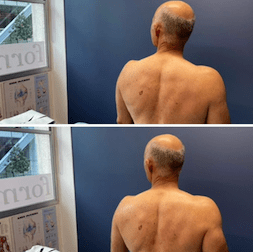Acute Wry Neck
There are a variety of different types of Wry Neck, varying in severity, origin and prognosis, however all these types of Wry Neck are characterized by unilateral (one sided) neck symptoms and pain in the neck region (although pain may also be felt in other areas).
Wry Neck Types
The two main types of Wry Neck we see at Function & Form are Acute and Discogenic Wry Neck. Although we have treated many patients over the years with Spasmodic Torticollis, it is not very common.
1. Acute Wry Neck
The predominant group that presents with acute wry neck pain are female aged 12-25 years of age. Symptoms present following no specific incident or following a trivial event like sleeping or lying on the couch watching television.
The cause the dysfunction is unknown but hypothesized to be entrapment of a structure at the cervical facet joint whether that be fat pad, meniscus or joint capsule.
For most patients presenting with this type of injury there may be no pain at rest, and can adopt a neck position that does not provoke pain. The resting head position adopted may be slightly rotated (turned) or laterally flexed (bent to the side), to avoid pain. Sudden and sharp pain is felt on active movement of the neck, particularly rotating or laterally flexing to the side opposite the side of pain.
On the positive side, Acute Wry Neck pain, responds well and quickly to treatment, but unfortunately repeat episodes are common.
At Function & Form we often treat this injury with, passive intervertebral mobilizations with rotation or lateral flexion towards the pain free (opposite direction). Massage to the adjacent muscles also assists in achieving pain relief and the ability to return to a more aligned head position. Taping to relieve muscle spasm and assist postural education and provide support. We also send the patient home with exercises specific to their injury and capabilities so that improvements may continue between treatment sessions. Our particular strength is in providing advice and support in modifying daily activities and sport/ exercise so that other elements of health and fitness may be maintain whilst recovering from the specific injury.
2. Discogenic Wry Neck
Discogenic Wry Neck is most common in those 30- 60 years of age. Whilst symptoms are still unilateral (one sided), they may be felt at the neck and or descending the arm, shoulder and scapular region. Symptoms indicate irritation of the cervical nerve root.
Those patients presenting with this type of Wry Neck often experience stiffness or a limitation in neck movement prior to the onset of pain. For these patients resting pain is often a feature but unlike Acute Wry Neck patients they are usually able to adopt a normal resting head posture.
Without physiotherapy treatment these injuries risk progressing to nerve root irritation or compression. Unfortunately these injuries respond slower to treatment than the Acute Wry Neck and may require regular treatment.
At Function & Form we find that patients who present with this type of injury have had a long history of neck stiffness and many ignored "niggles" in the neck region. These patients have often have participated in sports that have placed their neck under strain through impact, falls and crashes,ie. heading balls in soccer, Others have adopted sub optimal neck postures during their working life with little or no postural strengthening, re-education or re-setting. The last group are the stomach sleeper who sleep in end range neck rotation, compromising nerve roots for long stretches of time.
The mid to low cervical spine is often implicated and specific treatment to this area will incorporate rotation, lateral flexion movements or passive physiological intervertebral mobilisation.
Long term management is our goal with these patients, addressing the causative factors and formulating an exercise plan to improve strength, positioning and postural endurance.
If you are experiencing neck pain book an appointment with our experienced physiotherapist.

Neck Rotation Pre-treatment (top)
and Post Treatment (below)
